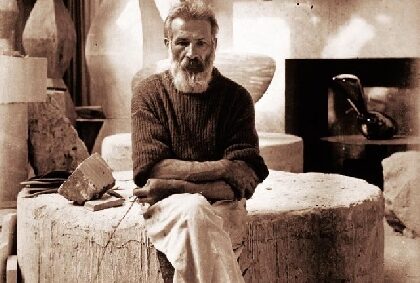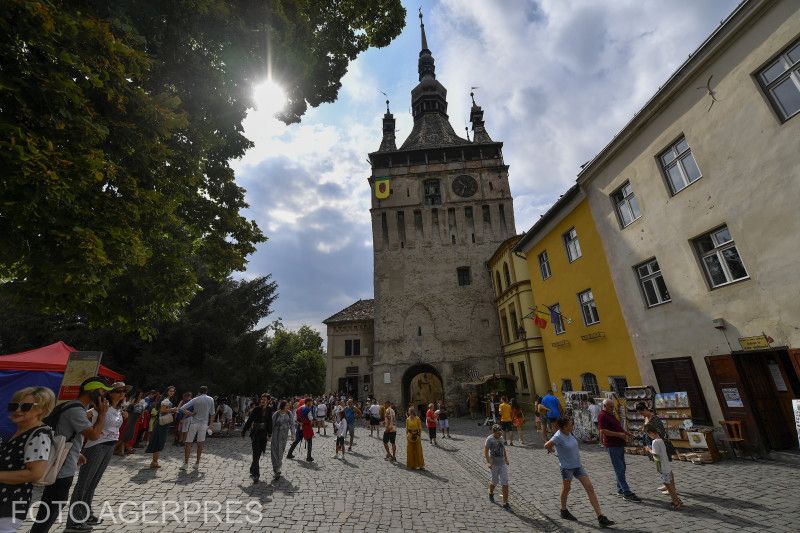Constantin Brâncuși’s journey from Romania to Paris
Constantin Brâncuși’s journey from the humble beginnings as the son of a poor carpenter

Christine Leșcu, 19.02.2024, 15:08
Constantin Brâncuși’s journey from the humble beginnings as the son of a poor carpenter to the artistic heights he achieved in Paris as a sculptor began in Hobița, a village in the northern part of historical Oltenia, where Brâncuși was born on 19th February 1876. It was from here that he set off, at the start of the 20th century, to Western Europe, which was more welcoming than his native Romania to his art, one that was nevertheless imbued with the traditions of his kin, and a closeness to nature. Before he left for Paris, Brâncuși attended primary school in his village and then went to the School of Arts and Crafts in Craiova, before enrolling at the Academy of Fine Arts in Bucharest, which he graduated in 1902. It was about that time that he decided to leave Romania, but nothing is certain when it comes to the artist’s personal biography. Very little is also known about his personality and way of thinking, so the man behind the artist is difficult to reconstruct. However, any endeavor to understand him has to include the journey that led to his achieving fame abroad, a journey Sorin Trâncă recreated recently and described in a book entitled ‘Constantin’s Journey, Brâncuși’s Escape from Romania, a Reconstruction’. Sorin Trâncă noticed from the start that there is very little actual information about Brâncuși’s journey:
“I began with the assumption that he left in 1903 and arrived in 1904. The writer Alexandru Vlahuta wrote in 1910 that this journey lasted four months. Some said it took eight months, others 14 or 16 months, even two years. There are many things that are not clear. My intention was to try to put forward a valid theory. After doing a lot of reading and carefully considering all the arguments and sources, I concluded that he must have left in 1903, sometime in late spring or early summer, and that he most likely arrived in Paris the next summer, around Bastille Day, on 14th July 1904. The journey would have taken him more than a year, but it’s still not certain if he indeed left in 1903, and not perhaps a year earlier, in 1902.”
According to Sorin Trâncă, Brâncuși most probably left from Hobița to Petroșani, in the Romanian Kingdom, and then he went to Transylvania, which at the time was part of the Austro-Hungarian Empire. Via Hațeg, he entered Hungary via Nădlac, passed through Budapest, entered Austria through Heidentor im Carnutum, travelled through Vienna, Linz, and Salzburg, and then into Germany, to Munich, Konstanz and further to Switzerland, where he seemingly fell ill, more precisely in Basel. After entering France, he traveled by train from Langres to Paris, where he is believed to have arrived on 14th July, for, as the artist wrote, ‘France welcomed me with a brass band and a military salute’. But how did Brâncuși travel and how did he finance his trip? Sorin Trâncă says the answers to these questions are still not clear:
“We know some important points that are validated by exegetes, by people who also knew him personally, like the lawyer and publicist Petre Pandrea. Basically, we know that he passed through Vienna, through Budapest, through Munich, through Basel, through Zurich and through Langres, on his way to France. And from here on I simply started to complete a map and make an itinerary starting from the hypothesis that Brâncusi made this journey in some way, on foot. This is another discussion. Many support this theory: that he walked like Badea Cârțan. I don’t think he did that, I think he rather went out into the world, like peasants or journeymen. (…) After finishing their apprenticeship, a journeyman is charged with taking this path to maturity, in which they must travel from one craftsman to another to learn new secrets of the trade. So, our peasant, Brâncusi, went out into the world, but he left as a journeyman, after finishing his apprenticeship in Bucharest, at the school of fine arts , a very good school by the way.”
What is known for sure, however, is that, after graduating the school, Constantin Brâncusi participated in various competitions for the creation of public monuments, all his proposals being rejected. Perhaps this rejection led Brâncusi to leave the country, but this too is only an assumption in the absence of direct testimony. Here is Sorin Trâncă:
“All the public works Brâncuși ever made were rejected. But there are also exceptions. One is related to the Târgu Jiu complex, but there we are talking about a person who was already almost 60 years old. (…) So, in Brâncuși’s old age, few people could correct his works. But, until then, all his public works were rejected. Other exceptions are public monuments, but commissioned by private individuals, such as those in the Buzău cemetery, so a funerary monument. (…) Although I refuse for the moment the categorical statements that Brâncusi really left Bucharest angry before arriving in Paris, it is possible that he left angry because of the spirit of mediocrity. (…) He is not a traveler in the modern sense, let’s say. I mean, in general, he left for work. He didn’t go out to have fun. (…) And, returning to childhood, Brâncuși’s departure from Hobita to Paris, on foot, I think, it is his fifth departure from home, if not even the sixth, because he ran away several times between 7 and 11 years of age. But there are also his departures from home, the sheepfold, around the age of 5. He is a child of the sheepfold, being poor and coming from a family with many children. From a young age he is sent elsewhere to build a life for himself. First time he was sent to a sheepfold in the Parâng Mountains. It’s the reason why Brâncusi didn’t really do serious school studies as a child, and almost misses primary school.”
Eager to be himself, following his original path for this purpose, Brâncusi would succeed, in Paris, in forging the much-sought-after forms in sculpture and, in addition, in making them admired by the entire world.































